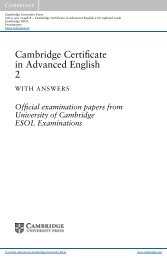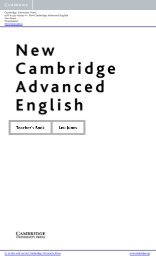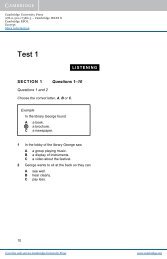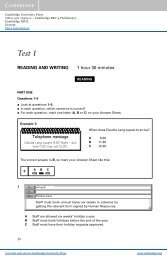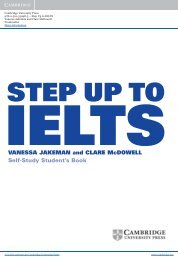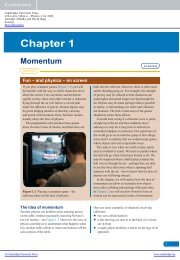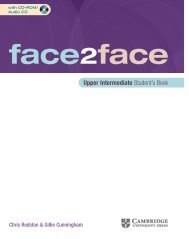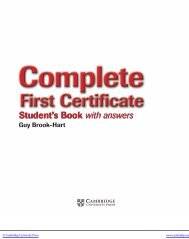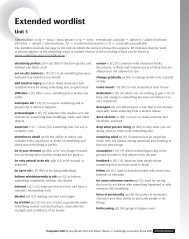Note: In the next series of activities, students practise intensive reading by readingand comparing slightly different versions of otherwise identical texts. The changesare limited to one or two words in most cases, but have a potentially significantimpact on the author’s argument or apparent stance.2cAnswersMain idea:Italy produced the most realistic and beautiful art during the fifteenth andsixteenth centuries through using inspiration from classical Rome (proportion)and new scientific techniques (perspective).Supporting in<strong>for</strong>mation:This period is called the Renaissance (revival) in reference to the rediscovery ofclassical knowledge and <strong>for</strong>ms in art. Italian Renaissance artists aimed to maketheir art represent reality.How Italian artists made their paintings realistic:Italian art captured genuine images of the human <strong>for</strong>m. They used classicalknowledge about proportion and contemporary scientific or mathematicaldiscoveries about perspective.The style of painting in Northern Europe:According to the writer, the Renaissance had no effect on Northern Europeanart, which was flat and less true-to-life than in Italy. Jan Van Eyck’s art in theNetherlands aimed to create realism, but was less effective and beautiful thanItalian art as he didn’t use teachings on perspective and proportion.2d Note: Changes in Text B are underlined in the text below, with the implications ofthose changes written in italics.AnswersText BEurope created beautiful, and realistic, art in the fifteenth and sixteenth centuries (thewhole of Europe, not just Italy). This period is known as the Renaissance, or ‘revival’,because it moved away from the less life-like art of the Middle Ages (the periodbetween the Classical Age of ancient Greece and Rome, and the Renaissance)and revived the more true-to-life art of classical times (the language is more neutraland cautious here. It is less dismissive of art of the Middle Ages). Classical art wasthought to be more ‘real’ than art in the Middle Ages because it aimed to capturea genuine image of the human <strong>for</strong>m: people looked like real people (again, morecaution used here). Renaissance artists revived this reality, or ‘truth’, in their art,with classical writing on proportion and contemporary Italian scientific discoveriesabout perspective, helping to make this possible (the other text says that proportionand perspective were the ‘only’ way this was possible; this text is more open to theidea that other techniques helped to create beautiful and realistic art). Mathematicsassisted artists in the recreation of nature’s beauty in sculpture, architectureand paintings: human beings could be represented with accurate proportions;landscapes could be recreated on flat walls as though a window had been openedto the world (more caution here, and no emphasis just on Italian artists). At the sametime, art in Northern Europe was less affected by Renaissance teachings (caution:suggestion that it was affected, but not as strongly as in other places). While someart continued to be created in a flat, less true-to-life, manner, Jan van Eyck (1390?–1441), of the Netherlands, did try to make his paintings realistic (suggestion that vanEyck not following tradition of Dutch art of the Middle Ages, whereas the other textsuggests that his art still inferior to Italian). He copied minute detail such as individualhairs in an animal’s fur and strands in a tapestry to make his images seemUnit 4 Part B ∙ Understanding written in<strong>for</strong>mation 112
true-to-life, but did not try to recreate the world only by using the Italian techniquesof perspective or proportion (suggestion that he did also use perspective andproportion in his art). Jan van Eyck did make his painting beautiful and realisticthrough making his art colourful and detailed, with his art no less effective in terms ofbeauty and reality than his Italian counterparts’ (more definite here – text A says ‘tryto make’; certain that van Eyck’s art as effective as Italian art in terms of beauty andreality).2e Students check their answers.2f Student discussionAnswers1 Text A2 Italian renaissance art used ideas from classical Italy about proportion andnew ideas about perspective to create more realistic art; Northern Europeanart not using the same techniques and was not so effective.3 Yes, with the comment that he was not ‘only’ using Italian techniques,suggesting that he was using some Italian techniques.4 Northern European (Dutch) art focused on detail and colour to capture beautyand reality, and less on perspective and proportion.5 Text B. It is more cautious in terms of the language used. Nevertheless, theauthor’s views are strong, especially in the final sentences.Note: Activities 2f–2h give more of the same practice with intensive reading asin activities 2b–2e, and are not aiming at a different teaching point: they canthere<strong>for</strong>e be considered optional. The texts in these activities centre on the conceptof ‘contrapposto’ stance. This was first used in ancient Greek sculpture to give theimpression of life in depictions of human beings. The contrapposto stance puts theweight of the figure being represented onto one leg, with the subject’s arms andshoulders moving in the other direction to give the illusion of movement. This wasin contrast to the previously static, ‘unrealistic’, images of humans where weightwould be evenly distributed on both legs. This technique was revived during theRenaissance with the dual purpose of bringing to mind classical art, which wasundergoing a revival, and imbuing figures in art with more life, or realism.2g Student discussionSuggested answers1 Depends on students’ own opinions.2 Depends to an extent on students, but the sculpture on the left is less life-likethan the figure on the right. The figure on the left is standing in a position thatdoes not seem realistic (this is known as the Gothic ‘S-shape’ curve). The hairis unnatural, or stylized. The figure on the right is standing in a more naturalmanner, seemingly ready <strong>for</strong> movement. You can see his figure beneath theclothing, and his facial expression appears more natural.Note: The figure on the left is an example from the Middle Ages, and is typical ofdepictions of humans at that time (stylized, less true to life). The figure depictsSaint Barbara. The sculpture on the right is from Classical Rome and is a goodexample of ‘contrapposto’ (see below <strong>for</strong> more detail about this technique).Unit 4 Part B ∙ Understanding written in<strong>for</strong>mation 113
- Page 1 and 2:
Skillsfor StudyLEVEL 2Teacher’s N
- Page 3 and 4:
IntroductionThe Skills and Language
- Page 5 and 6:
Introductioncases, even in texts wh
- Page 7 and 8:
Unit 1Gender issuesUnit OverviewPar
- Page 9 and 10:
Women are oftenenrolled on lesspres
- Page 11 and 12:
2b Students take turns presenting t
- Page 13 and 14:
Note: There is a deliberate flaw in
- Page 16 and 17:
Passage cGender gap in higher educa
- Page 18 and 19:
3dAnswersThe correct readings are:F
- Page 20 and 21:
Unit Task: The gender gap1 Students
- Page 22 and 23:
1fAnswersFaiola, A. (2008, May 16).
- Page 24 and 25:
Copy information directlyfrom a lab
- Page 26 and 27:
European Commission. (2009). She Fi
- Page 28 and 29:
2cSuggested answersAccording to Fig
- Page 30 and 31:
Suggested answersGraphic Strengths
- Page 32 and 33:
Suggested answersFeatureStructures
- Page 34 and 35:
Quite separately from the issue of
- Page 36 and 37:
5b Group discussion5c Students inve
- Page 38 and 39:
Unit 2WaterPart AUnderstanding spok
- Page 40 and 41:
1jAnswersYes, I agreeOn top of that
- Page 42 and 43:
Assignment 1aAnswersArid: A very dr
- Page 44 and 45:
Assignment 2Note: The unit task for
- Page 46 and 47:
1c Group discussion1dSuggested answ
- Page 48 and 49:
3dSuggested answers1 To determine w
- Page 50 and 51:
Part CInvestigatingThe aim of this
- Page 52 and 53:
3aSuggested answersList all the pos
- Page 54 and 55:
4bSuggested answers1 introductory s
- Page 56 and 57:
4hSuggested answerProbably not real
- Page 58 and 59:
Part DReporting in speechThe aim of
- Page 60 and 61:
4bSuggested answersYou want to go b
- Page 62 and 63: Part EReporting in writingThe aim o
- Page 64 and 65: 2cSuggested answersDetermining the
- Page 66 and 67: 3gExample of the rewritten sectionE
- Page 68 and 69: BDiscussionFlow rate increases with
- Page 70 and 71: Suggested answers1Feasibility repor
- Page 72 and 73: water sources is that considerable
- Page 74 and 75: we therefore recommend that the com
- Page 76 and 77: Unit 3ProgressPart AUnderstanding s
- Page 78 and 79: 4b See 4c for answers.4cAnswers3.5S
- Page 80 and 81: Unit Task: Traditional, complementa
- Page 82 and 83: 2dAnswersBeginning / ending of a se
- Page 84 and 85: 4bAnswersDate Test subjects Effects
- Page 86 and 87: Part CInvestigatingThe aim of this
- Page 88 and 89: 2bSuggested answers• Only a littl
- Page 90 and 91: Passage 3aStudies of acupuncture al
- Page 92 and 93: 4eSuggested answers1Presents factua
- Page 94 and 95: One study by the WHO indicates that
- Page 96 and 97: Part DReporting in speechThe aim of
- Page 98 and 99: Unit Task: Traditional, complementa
- Page 100 and 101: 1gSuggested answersSource A (Kirkup
- Page 102 and 103: Source B: Cohen, 2009.Paragraph Mai
- Page 104 and 105: So far I have successfully complete
- Page 106 and 107: Unit 4Art, creativity and designPar
- Page 108 and 109: 4.23aSuggested answers1 The survey
- Page 110 and 111: defStudents listen again to judge t
- Page 114 and 115: 2hAnswersDefinition of contrapposto
- Page 116 and 117: 3 Reading critically3aAnswersAbilit
- Page 118 and 119: Dürer’s 1495 drawing is of class
- Page 120 and 121: To summarize, art and architecture
- Page 122 and 123: 2 Analyzing the suitability of samp
- Page 124 and 125: Part DReporting in speechThe aim of
- Page 126 and 127: 2fAnswers1 Speaker 1 gives an expli
- Page 128 and 129: 1c Note: As this activity depends t
- Page 130 and 131: Example research proposal abstract
- Page 132 and 133: 2iExample abstractFeatures of the p
- Page 134: The terms ‘Harvard style’, ‘H



